Last Updated on February 1, 2025 by Kittredge Cherry

(Trigger warning: violience.) On Ash Wednesday queer martyrs rise from the ashes as Q Spirit recalls the thousands who were executed for homosexuality throughout history. Many executions were fueled by religion-based hate.
This is not just a historical issue. The death penalty for homosexuality continues in at least seven countries.
Christians traditionally put ashes on their foreheads as a sign of repentance on Ash Wednesday (March 5, 2025). Ash Wednesday begins the season of Lent, a period of repentance in preparation for Easter, and is an appropriate time to reflect on the sins of the church and state against queer people, including the burning of “sodomites” and thousands of executions for homosexuality over the past 800 years. This is not intended to diminish the importance of other lives and other sins.
Some of the executions for sodomy were recorded by artists, either long ago or in recent times. This post features artwork, both new and historical, to remember and honor queer lives that were were desecrated and cut short.
Another LGBTQ-affirming approach to the holiday is “Glitter+Ash Wednesday.” The annual event has been coordinated by the LGBTQ Presbyterian group Parity since 2107. They encourage visibility of LGBTQ Christian people and allies by mixing glitter with the traditional grey ashes.
The whole sad history of church- or state-sanctioned executions of queer people stretches from the 13th century almost to the present. For the first 1,000 years of church history, Christianity was relatively tolerant of homoerotic relationships.
Then came campaigns of terror that started to use the terms “heresy” and “sodomy” interchangeably. Eventually hostility began to be directed at same-sex erotic behavior in particular. Sometimes “sodomy” included not only homosexual acts, but gender transgressions such as cross-dressing. Executions for sodomy focused on European men, but also extended to women and indigenous peoples.
Long history of executions for sodomy
For its first thousand years, Christianity was fairly tolerant of homosexuality and even honored queer love through paired same-sex saints, “brother-making” commitment ceremonies for male couples, and homoerotic devotional imagery. Christian art usually celebrated Jesus as the Good Shepherd or the ruler of God’s bountiful creation.
A shift began when the church joined forces with political and military powers near the end of Christianity’s first millennium. The oldest surviving crucifix with a dead Jesus is the Gero Cross from 970. The life-sized wooden sculpture was carved by the descendants of Saxons who survived vicious military campaigns led by Charlemagne. The Pope crowned him as Holy Roman Emperor in 800, and soon he forced Christianity upon the native cultures of Europe. In what is now Germany, Charlemagne’s armies killed or deported thousands of Saxons and chopped down the sacred tree of their indigenous religion.
As the centuries passed, Jesus’ death on the cross was portrayed with increasing intensity and realism. Crucifixion scenes spread across Europe, along with a new theology of atonement. Christians were urged to imagine themselves at the foot of the cross and contemplate Christ’s agony as he was killed to atone for their own particular sins. People who felt guilty for killing Jesus were less likely to resist domination. The Gero Cross expressed the anguish of a conquered people, but it also served to normalize violence. Leaders expanded their use of religion to justify bloodshed with the first Crusade in 1095. As crucifixion art proliferated, hostility began to be directed specifically at same-sex erotic behavior.
Terence Weldon of Queering the Church discusses the fateful period when the atrocities began in a well researched overview titled “Lest We Forget: The Ashes of Our Martyrs”:
In 1120, the Church Council of Nablus specified burning at the stake for homosexual acts. Although this penalty may not immediately have been applied, other harsh condemnations followed rapidly. In 1212, the death penalty for sodomy was specified in in France. Before long the execution of supposed “sodomites”, often by burning at the stake, but also by other harsh means, had become regular practice in many areas.
The Council of Nablus set a new precedent in medieval church law. Then came campaigns against heresy, which often used the terms “heresy” and “sodomy” interchangeably.
The church contributed to the deaths of thousands for homosexuality over the next 700 years. Witch burning occurred in the same period and claimed the lives of countless lesbian women whose non-conformity was condemned as witchcraft. (Current events in Uganda and elsewhere prove that some are STILL using Christianity to justify the death penalty for homosexuality up to the present day.) As Weldon concludes:
Obviously, the Catholic Church cannot be held directly responsible for the judicial sentences handed down by secular authorities in Protestant countries. It can, however, be held responsible for its part in fanning the flames of bigotry and hatred in the early part of the persecution, using the cloak of religion to provide cover for what was in reality based not on Scripture or the teaching of the early Church, but on simple intolerance and greed.
It is important as gay men, lesbians and transgendered that we remember the examples of the many who have in earlier times been honoured by the Church as saints or martyrs for the faith. It is also important that we remember the example of the many thousands who have been martyred by the churches – Catholic and other.
Images show history of sodomy executions
This first set of historical images shows sodomy executions of European men in chronological order. It is followed by sections on women, indigenous people and recent times.
___________________________________
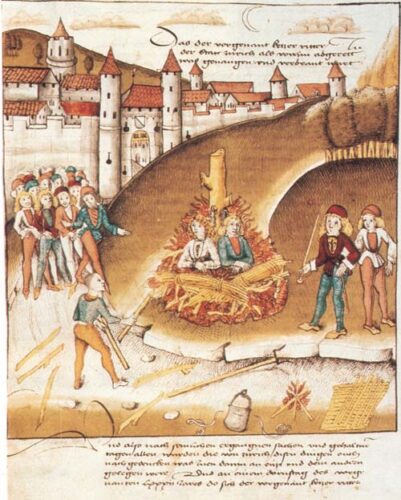
The knight of Hohenberg and his servant, accused of sodomy, were executed by burning in Zürich in 1482. (Wikimedia Commons)
The Alsatian knight Richard Puller von Hohenburg and his servant, Anthony Mätzler, accused sodomites, were executed by burning before the walls of Zurich, Switzerland in 1482. From illustration in Die Grosse Burgunderchronik by Diebold Schilling de Altere, c. 1483.
More info:
1482: Richard Puller von Hohenburg and Anthony Mätzler (ExecutedToday.com)
____________________________________
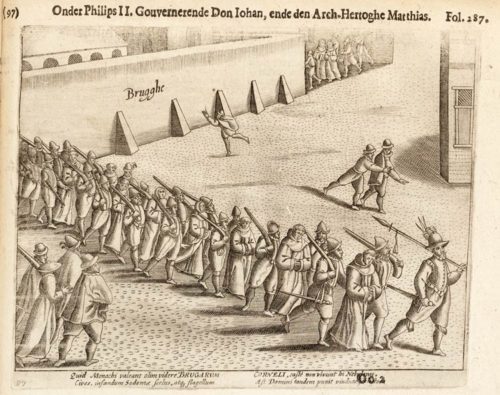
“Discovery of sodomy in a monastery in Bruges” by Frans Hogenberg, 1578 (Wikimedia Commons)
An engraving dated May 18, 1578 shows a long line of monks being marched out of a monastery in Bruges, Belguim, under armed guard after “sodomy” was discovered there. The title and verses explain that the revelations came from two Franciscans with Calvinist leanings after they were whipped and interrogated. As a result, “they were all taken prisoners and led away to the gate for their godlessness.”
____________________________________
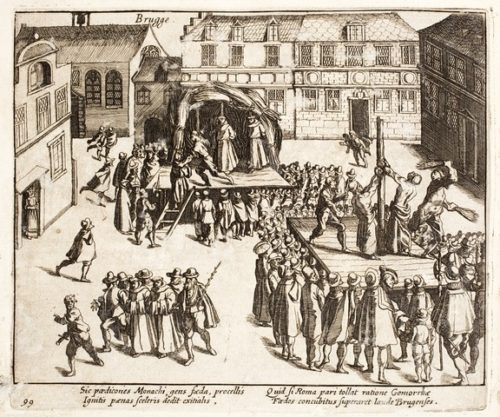
“Execution for Sodomitical Godlessness in the City of Bruges” by Frans Hogenberg, 1578 (Wikimedia Commons)
The consequences of the investigation are shown in another engraving in the series. Dated July 26, 1578, it shows two scaffolds in the public square. Three Fransciscan monks are about to be executed by burning while two are flogged. The inscription adds that two younger monks (in the left foreground) were banished “for they were young and inexperienced and had been seduced by the old ones, so that they unjustly practiced sodomy (unzuchtt) upon their bodies.”
More info:
1578: Three Bruges Minnenbroder (ExecutedToday.com)
“Same-Sex Desire in the English Renaissance: A Sourcebook of Texts, 1470-1650,” edited by Kenneth Borris
____________________________________

Execution of sodomites in Ghent in 1578 — drawing by Franz Hogenberg (Wikimedia Commons)
Five Catholic monks were burned to death for homosexuality on June 28, 1578, in Ghent, Belgium. The inscription explains that four were Franciscans and one was Augustinian.
More info:
1578: Five sodomite monks, by Calvinist Ghent (ExecutedToday.com)
“Same-Sex Desire in the English Renaissance: A Sourcebook of Texts, 1470-1650,” edited by Kenneth Borris
____________________________________
 A same-sex wedding was planned between Gasparo Vittorio of Monzon and Brother Gioseffe at the the Basilica of Saint John at the Latin Gate on the outskirts of Rome. Gioseffe didn’t show, but a group of 11 including Gasparoy were arrested on July 20, 1578 and executed on Aug. 13, 1578 in Rome. Their story is covered in the 2016 book “Same-Sex Marriage in Renaissance Rome: Sexuality, Identity and Community in Early Modern Europe” by Gary Ferguson.
A same-sex wedding was planned between Gasparo Vittorio of Monzon and Brother Gioseffe at the the Basilica of Saint John at the Latin Gate on the outskirts of Rome. Gioseffe didn’t show, but a group of 11 including Gasparoy were arrested on July 20, 1578 and executed on Aug. 13, 1578 in Rome. Their story is covered in the 2016 book “Same-Sex Marriage in Renaissance Rome: Sexuality, Identity and Community in Early Modern Europe” by Gary Ferguson.
____________________________________
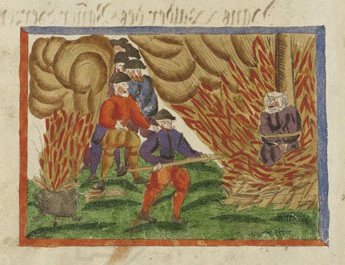
Miniature shows sodomy execution in Lenzburg, Switzerland, on May 28, 1586. (Wikimedia Commons)
A trans woman who adopted the name Barbara Brunner was burned in Lenzburg, Switzerland, on May 28, 1586. The same day a man was executed between Lenzburg and Aarau for sodomy. Miniature from the manuscript “News collection on contemporary history from the years 1560-87 (with more older songs)” (Sammlung von Nachrichten zur Zeitgeschichte aus den Jahren 1560-87 (mit älteren Stücken) by Johann Jakob Wick.
____________________________________
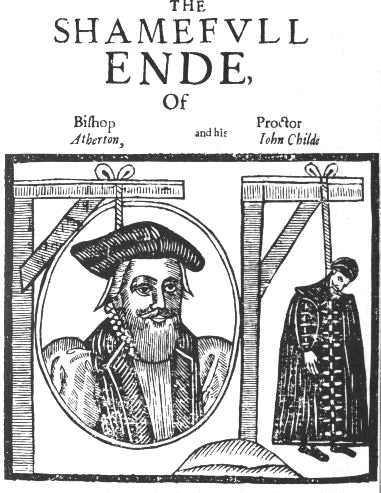
“The Shameful End of Bishop Atherton and his Proctor John Childe,” hanged for sodomy in 1641 in Dublin (Wikimedia Commons)
John Atherton, Anglican bishop of Waterford and Lismore, and his lover John Childe were hanged for “buggery” in 1640 in Dublin, Ireland. The bishop was executed under a law that he helped to institute! The picture comes from an anonymous 1641 booklet titled “The Shameful End of Bishop Atherton and his Proctor John Childe.” The title tries to shame and blame the victims, but the shame belongs to the church and society who killed them for who and how they loved.
____________________________________
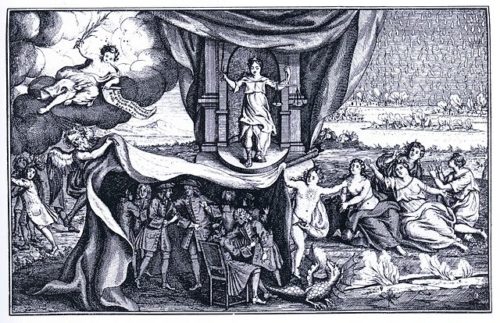
Allegories of Truth and Virtue uncover a group of sodomites in an engraving from 1730. (Wikimedia Commons)
An anonymous engraving from 1730 is titled “Representation of the Netherlands destroyed by water and fire, while allegories of Truth and Virtue uncover a group of sodomites.” Justice looks at it from above, as does a figure holding a flaming sword and a scroll that reads “Men, leaving the natural use of the woman” (Romans 1:27). The implied meaning is that Dutch sodomites will incur God’s wrath, leading to the destruction of the Netherlands.
____________________________________
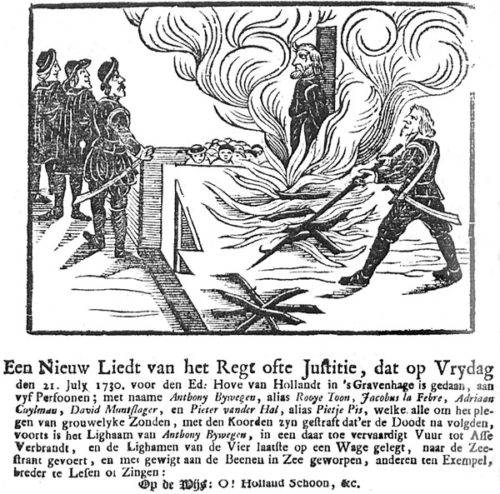
“Burning Sodomite” engraving by Anthony Bywegen, 1730 (Wikimedia Commons)
Another “burning sodomite” is shown in a 1730 Dutch engraving. It appears to show the execution of Anthony Bywegen (alias Rooye Toon, Jacobus la Febre, Adriaan Cylman, and David Muntglafer) and Pieter van der Hal (alias Pitje Pis), based on a new edict issued on July 21, 1730, calling for public execution of sodomites in the Netherlands.
____________________________________
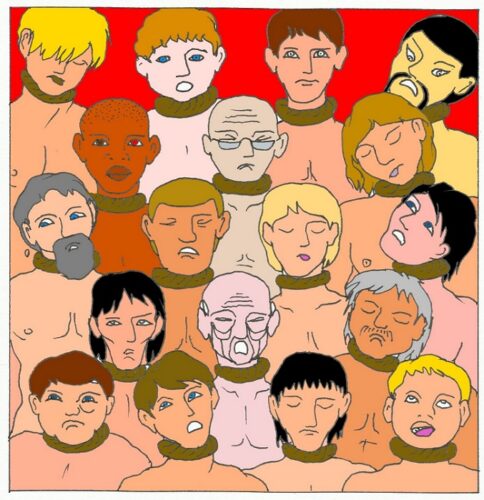
Eighteen “sodomites” were executed by strangling in 1731 in Utrecht, the Netherlands. They are portrayed in the book “Heavenly Homos, Etc.: Queer Icons from LGBTQ Life, Religion, and History” by Jan Haen, a Dutch artist and Roman Catholic priest in the Redemptorist order.
____________________________________
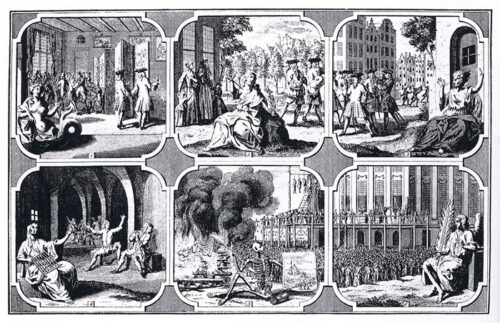
“Timely Punishment Depicted as a Warning to Godless and Damnable Sinners” shows Dutch massacre of sodomites in Amsterdam in 1730-31 (Wikimedia Commons)
A total of 96 gay men were executed for sodomy in the Netherlands years 1730-31.
____________________________________
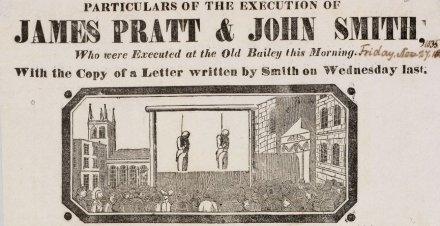
Newspaper clipping from the sodomy execution of James Pratt and John Smith, 1835 (lgbthistoryuk.org)
The last men executed for sodomy in England were two London men: James Pratt and John Smith in 1835. They hanged in front of London’s Newgate Prison on Nov. 27, 1835. Court records say that they “feloniously, wickedly, diabolically, and against the order of nature, carnally … commit and perpetrate[d] the detestable, horrid, and abominable crime (among Christians not to be named) called buggery.” They are even described by the young Charles Dickens in an essay about his visit to Newgate, which appears in his collection “Sketches by Boz.”
More info:
The Final Two Executions For Sodomy In Britain – 1835. James Pratt & John Smith – A Travesty Of Justice! (TimAlderman.com)
1835: John Smith and James Pratt, the last hanged for sodomy in Great Britain (executedtoday.com)
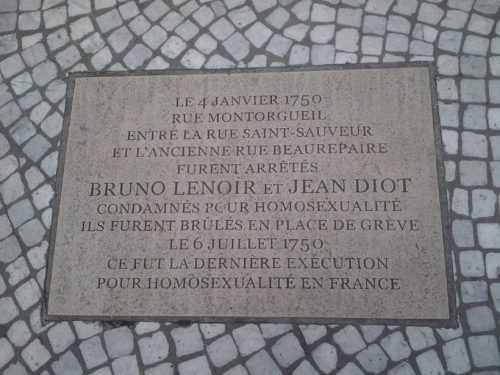
There is a memorial plaque in Paris for Jean Diot and Bruno Lenoir, the last French citizens known to be executed for homosexuality. They were killed on July 6, 1750. (Wikipedia)
____________________________________
Sodomy executions of indigenous people
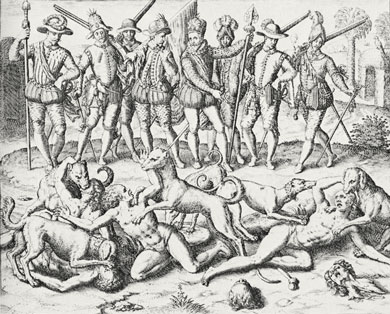
Balboa executing two-spirit Native Americans for homosexuality in 1513 in Panama — engraving by Théodore De Bry, 1594 (Wikimedia Commons).
The Spanish explorer Vasco Núñez de Balboa found homosexual activity among the Native American chiefs at Quarqua in Panama. He ordered 40 of these two-spirited people thrown to his war dogs to be torn apart and eaten alive to stop the “stinking abomination” in 1513 in Panama Executions for homosexuality continued during the “Mexican Inquisition,” an extension of the Spanish Inquisition into the New World. In one of the most notorious examples, 14 men were executed by public burning on Nov. 6, 1658 in Mexico City.
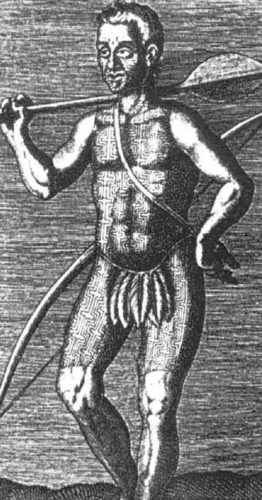
Historical image of Tibira do Maranhão
LGBTQ activists in Brazil recently launched a campaign for the sainthood of Tibira do Maranhão, who is considered “the first indigenous gay martyr of Brazil.” French missionaries executed him for sodomy in 1614, turning him into a queer martyr. It was the first documented case of a person killed for homosexuality in Brazil.
Tibira was a Tupinambá Indian living in Brazil’s northeastern coastal region of Maranhão. The word “tibira” referred to homosexuals in the Tupi language.
The missionaries executed Tibira by strapping him in front of a cannon and blowing him to pieces. The gruesome public spectacle designed to “extinguish evil” and terrorize the native population into a “Christian” lifestyle that shunned same-sex attraction. The only record of the execution comes from French Capuchin friar Yves D’Evreux, who wrote about it in his travel diary.
The history was buried for four centuries until it was rediscovered and highlighted by Grupo Gay da Bahia and its founder, anthropologist and historian Luiz Mott. Starting a few years ago, they made headlines across Brazil by asking the Roman Catholic Church to recognize Tibira. A detailed report in English was published by Vice.com in 2017.
More info about violence against two-spirit people is included in Q Spirit’s article on Indigenous Peoples Day.
Women were also killed for sodomy
Sodomy is often considered a male issue, but the facts of history make clear that queer women were persecuted under sodomy laws too. The meaning of sodomy has changed a lot over the centuries. The “sin of Sodom” in the Bible was described as arrogance and failure to care for travelers and the poor.
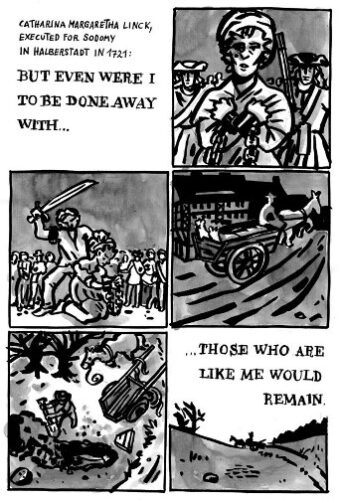
“Catharina Margaretha Linck, executed for sodomy in Halberstadt in 1721” by Elke R. Steiner. Steiner’s work is based on Angela Steidele’s book “In Männerkleidern. Das verwegene Leben der Catharina Margaretha Linck alias Anastasius Lagrantinus Rosenstengel, hingerichtet 1721.” Biographie und Dokumentation. Cologne: Böhlau, 2004. (“In Men’s Clothes: The Daring Life of Catharina Margaretha Linck alias Anastasius Rosenstengel, Executed 1721.”)
German artist Elke R. Steiner illustrates the last known execution for lesbianism in Europe. Born in 1694, Catharina Margaretha Linck lived most of her life as a man under the name Anastasius. She was beheaded for sodomy on Nov. 8, 1721 in Halberstadt in present-day Germany. Linck worked at various times as a soldier, textile worker and a wandering prophet with the Pietists. She married a woman in 1717. Her mother-in-law reported her to authorities, who convicted her of sodomy with a “lifeless instrument,” wearing men’s clothes and multiple baptisms. The subject is grim, but Steiner adds an empowering statement: “But even were I to be done away with, those who are like me would remain.”
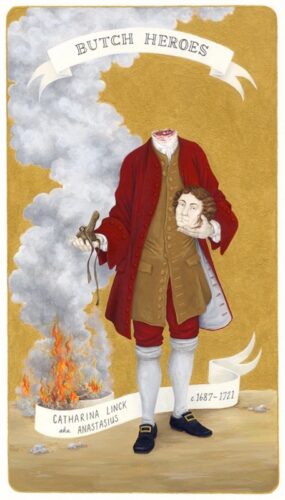
“Catharina aka Anastasius Linck” by Ria Brodell
Nonbinary trans Boston artist Ria Brodell portrays Linck and several other historical women who were killed for sodomy in the “Butch Heroes” series. They include Katherina Hetzeldorfer of Germany, drowned in 1477 for female sodomy, and Lisbetha Olsdotter aka Mats Ersson of Sweden, who was decapitated in 1679 for cross-dressing and other crimes. “Butch Heroes” is available as a book published in 2018 by MIT Press.
Recent executions for sodomy
Christianity is no longer used to justify state-sponsored executions for homosexuality, but religion is still a big factor in nations where executions continue.
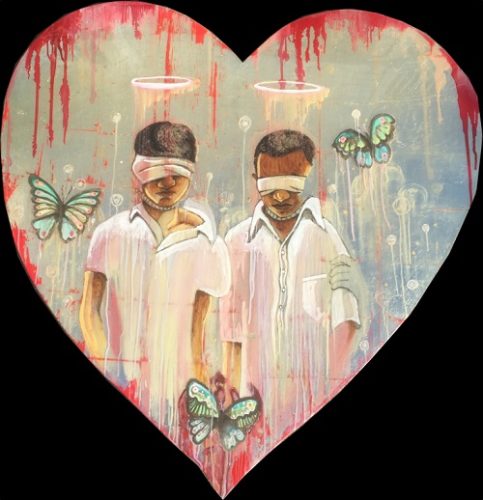
“Ayaz and Mahmoud” by Matt Pipes
A new artwork commemorates two Iranian teenagers who were killed in one of the more recent cases. “Ayaz and Mahmoud” by San Francisco artist Matt Pipes depicts Ayaz Marhoni and Mahmoud Asgari. They were executed by hanging in Mashaud, Iran on July 19, 2005 for violating Shari’a (Islamic law) in a case that drew international attention. They were convicted for homosexual rape of another teenage boy, but the British LGBT group Outrage! insisted that that they were lovers engaging in consensual homosexual sex. The facts of their particular case are still being debated, but the artwork is a poignant expression of the universal grief over executions of same-sex lovers for the “crime” of being gay.
Other recent examples include the Holocaust or “homocaust” of persecution by the Nazis, who sent an estimated 5,000 to 60,000 to concentration camps for homosexuality. Executions on homosexuality charges in Iran continued to make news multiple times since 2011.
Many more die in anti-LGBTQ attacks, including these:
2016 shooting at the Pulse gay night club in Orlando, Florida
2022 shooting at the Club Q nightclub in Colorado Springs
2022 shooting at the Oslo LGBTQ Pride event in Norway
1973 arson fire at the UpStairs Lounge, a gay bar in New Orleans
Anti-LGBTQ oppression drives some to suicide, including codebreaker Alan Turing, South Korean poet Yook Woo-Dang, US student Tyler Clementi and young American woman Alana Chen. Others die due to an “intersectional” mixture of anti-LGBTQ hate and racism or other forms of discrimination, such as the trans women migrants who were denied medical care and allowed to die when they sought asylum in the United States. In a sense LGBTQ holocausts are happening all over the world, all the time.
News reports chronicle some of the other 21st-century executions for homosexuality:
Rights group: Iran executes 2 gay men over sodomy charges (AP News, Feb. 1, 2022)
Five men beheaded by Saudi Arabia were gay according to ‘confessions extracted under torture’ (Metro.co.uk, April 27, 2019)
Iran’s New Gay Executions (Daily Beast, 8/12/2014)
“Two men, Abdullah Ghavami Chahzanjiru and Salman Ghanbari Chahzanjiri, were hanged in southern Iran on August 6, possibly for consensual sodomy…”
Four Iranian men due to be hanged for sodomy (Pink News, 5/12/2012)
“Iran court sentenced four men… to death by hanging for sodomy… named ‘Saadat Arefi’, ‘Vahid Akbari’, ‘Javid Akbari’ and ‘Houshmand Akbari.’”
Iran executes three men on homosexuality charges (guardian.com 9/7/2011)
Prayers, hymns and poetry for Ash Wednesday
I created my own Ash Wednesday prayer to counteract the negative messages imposed on LGBTQ people:
We are light, and to Light we will return!
This is a queer counterpoint to go with the usual Bible reading for Ash Wednesday: “You are dust, and to dust you will return” (Genesis 3:19).
Q Spirit’s Litany of Queer Saints includes some of the people named in this article and this line:
Blessed be all the queer lives lost due to ignorance and hatred.
Martin Luther, catalyst of the Protestant Reformation, wrote a little-known hymn about the ashes of martyrs in 1523. He was outraged when he learned that two Augustinian monks were burned at the stake for heresy in Brussels. He turned his anger into song. Today his lyrics seem to speak of the queer martyrs too:
Flung to the heedless winds,
Or on the waters cast,
The martyrs’ ashes, watched,
Shall gathered be at last.
And from that scattered dust,
Around us and abroad,
Shall spring a plenteous seed,
Of witnesses for God.
Their loving God received,
Their latest living breath,
And vain is any boast
Of victory in their death.
Still, still, though dead, they speak,
And, trumpet-tongued, proclaim,
To many a wakening land,
The one availing Name.
Milder forms of anti-LGBTQ persecution continue in the church. Now it is common to freeze LGBTQ people out of church leadership positions. Gay pastor and author Chris Glaser writes about the exclusion from clergy roles as a “fast imposed by others” in the following prayer based on the practice of fasting during Lent, the season of individual and collective repentance and reflection between Ash Wednesday and Easter.
One: Jesus,
our fast has been imposed by others,
our wilderness sojourn their choice more than ours.
Many: Our fast from the sacraments,
our fast from ordination:
our only choice was honesty.
One: With the scapegoats of the ancient Hebrews,
sexual sins of generations
have been heaped upon our backs,
and we have been sent away,
excommunicated, into the wilderness to die.
Many: Yet we choose life,
even in our deprivation
One: Jesus, lead us to discern our call
parallel to your own:
rebelling against the boundaries,
questioning the self-righteous authorities,
breaking the Sabbath law
to bring healing.
This prayer comes from “Rite for Lent” by Chris Glaser, published in Equal Rites: Lesbian and Gay Worship, Ceremonies, and Celebrations. Glaser spent 30 years struggling with the Presbyterian Church for the right to ordination as an openly gay man before he was ordained to the ministry in Metropolitan Community Churches in 2005. He writes progressive Christian reflections at chrisglaser.blogspot.com.
“Faggots We May Be,” a 2015 poem by Georgia poet S. Alan Fann, makes connections between gay men burned to death, global warming and the Rainbow Christ.
“Pilloried”, a poem by Andrew Craig Williams, is based on a news report from Nov. 12, 1726: “Two persons stood in the Pillory this Week for Sodomy, and were sadly maul’d.”
It is horrifying to remember the “burning times,” especially for those LGBTQ people who consider themselves part of the Christian tradition. Let us rise from the ashes with these verses from the Bible:
Create in me a clean heart, O God, and put a new and right spirit within me.
For thou hast no delight in sacrifice; were I to give a burnt offering, thou wouldst not be pleased.
[Psalm 51: 10, 17]
Is such the fast that I choose,
a day for a you to humble yourself?
Is it to bow down your head like a rush,
and to spread sackcloth and ashes under you?
Will you call this a fast, and a day acceptable to God?
Is not this the fast that I choose:
to loose the bonds of wickedness,
to undo the thongs of the yoke,
to let the oppressed go free,
and to break every yoke?
Is it not to share your bread with the hungry,
and bring the homeless poor into your house;
when you see the naked, to cover them,
and not to hide yourself from your own flesh?
Then shall your light break forth like the dawn,
and your healing shall spring up speedily.
[Isaiah 58:5-8]
Books related to executions for sodomy and homosexuality
Homosexuality and Civilization by Louis Crompton
“Same-Sex Desire in the English Renaissance: A Sourcebook of Texts, 1470-1650,” edited by Kenneth Borris
“Unfinished Lives: Reviving the Memories of LGBTQ Hate Crimes Victims” by Stephen Sprinkle
Links related to LGBTQ Ash Wednesday, Lent, and executions for sodomy and homosexuality
“Burned for sodomy” (Queering the Church)
Lest We Forget: The Ashes of Our Martyrs (Queering the Church)
The blood-soaked thread (Wild Reed)
List of people executed for homosexuality in Europe (Wikipedia)
LGBT Victims (Gay History Wiki)
List of people killed for being transgender (Wikipedia)
Victims of anti-LGBT hate crimes (Wikipedia)
“Victims of Hate” gallery on Facebook
List of acts of violence against LGBT people (Wikipedia)
BURN BABY BURN: A Knight, a Squire, a Bishop, a Steward, Five RC Monks and Millions of murders initiated by bigots at Church! (Eruptions at the Foot of the Volcano Blog)
The Gay Holocaust (Matt and Andrej Koymasky)
A History of Homophobia (Rictor Norton)
Homosexuals and the Death Penalty in Colonial America by Louis Crompton
‘Glitter Ash Wednesday’ sparkles for LGBT Christians and others (ReligionNews.com)
Ex-gay movement as genocide (Jesus in Love)
___
Top image credit:
Detail from “Timely Punishment Depicted as a Warning to Godless and Damnable Sinners,” an engraving showing the Dutch massacre of sodomites in 1730-1731. Published in Amsterdam, 1731. (Wikimedia Commons)
___
This post is part of the LGBTQ Calendar series by Kittredge Cherry. The series celebrates religious and spiritual holidays, events in LGBTQ history, holy days, feast days, festivals, anniversaries, liturgical seasons and other occasions of special interest to lesbian, gay, bisexual, transgender and queer people of faith and our allies.
This article has evolved and expanded greatly since the first version was posted in March 2011. It was published on Q Spirit in February 2017, was expanded with new material over time and most recently updated on Jan. 22, 2025.
Copyright © Kittredge Cherry. All rights reserved.
Qspirit.net presents the Jesus in Love Blog on LGBTQ spirituality.

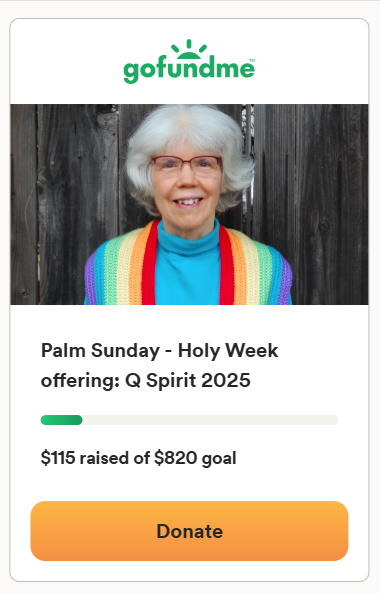















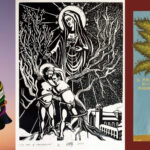




I was aware of the history, even recent but your thorough research was very elucidating. Thank you, the fight goes on, may the threat be told and may light shine forth.
One suggested edit: “trans woman” should have a space in the middle, making it two words, adjective and noun. (If you think of ‘trans’ as short for ‘transgender’ instead of a prefix in its own right here, that makes it easier to remember to make it two words.) Aside from that orthography quibble, a fine article!
Thank you. I understand your point and made the correction that you suggested. Blessings to you on Ash Wednesday!
This article claims “For its first thousand years, Christianity was fairly tolerant of homosexuality and even honored queer love through paired same-sex saints, “brother-making” commitment ceremonies for male couples, and homoerotic devotional imagery.” Again, this is based on John Boswell’s claims which have been refuted even by gay historians such as the late Alan Bray, which led even Paul Halsall to concede that “Boswell was wrong about nearly everything” (or words to that effect). The “brother-making” ceremonies were, as Bray pointed out, a common means of reconciling enemies, as in the case of Duke John the Fearless of Burgundy and his enemy Duke Louis of Orleans in 1407 (an example used by Bray). They were on the brink of war, and so their mutual uncle Duke Jehan de Berri forced them to swear the oath of brotherhood to try to force a reconciliation. They weren’t “gay lovers”, in fact shortly after swearing the oath of brotherhood the Duke of Orleans was assassinated by the Duke of Burgundy’s henchmen, setting off the war which their uncle had tried to prevent. But you think these guys (and similar cases) were gay lovers?
Thank you very much for a beautifully done article with a wealth of information. However, I found the idea of mixing glitter with ashes to be very ill conceived and demeaning to queer people. I refuse to have something as vapid and inconsequential as glitter represent my life.
I understand your point, but I want to report on creative ways that other LGBTQ people of faith are marking Ash Wednesday, including Glitter + Ash. For my own spiritual life, I created the phrase, “You are light, and to light you shall return.” This is in keeping with various Biblical texts, including Jesus’ words, “You are the light of the world.” I will find a way to add this into my article.
Regarding the executions of Anthony Bywegen, Jacobus la Febre, Adriaan Cylman, David Muntglafer and Pieter van der Hal: it was the result of a “witch hunt” which began in 1730 in the Dutch Republic, when two soldiers were discovered together. Rumours had been around earlier that there was a secret meeting place for homosexuals, and indeed the two men were found there. After they had bene captured, they were tortured in order to confess their crime and to name others. This turned into a nationwide investigation, which led to 96 men being convicted.
The five men named here were, according to the text on the plate, killed by strangling. Anthony’s body was then burned to ashes, whilst the others were thrown into the ocean, their bodies being weighed down with chains.
Thank you for additional details about the 1730 executions in the Netherlands. This information is hard to find, so your help is very valuable.
Thanks for a wonderful article, very thought-provoking. Just one small criticism: the phrase ‘a man dressed as a woman who identified herself as “Barbara Brunner” feels a bit jarring to this trans reader. Why not just refer to her as a trans woman who adopted the name of Barbara Brunner, without the quotation marks?
Thanks, Ash, I went ahead and made that change. It’s a continual challenge to translate history from the outdated and transphobic ways that it is recorded in earlier sources. I rely on readers like you for help and encouragement.
I will pray throughout the day at church and temples for an end to discrimination.